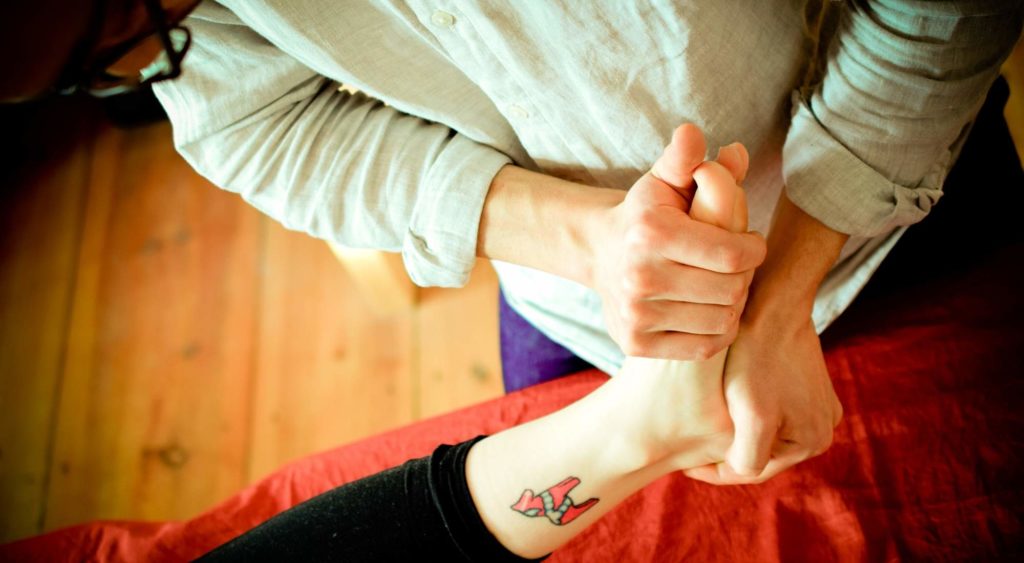Drop Foot Physical Therapy

Physical Therapy for Drop Foot — Information, Exercises, and More
If you are experiencing drop foot, you know how it can affect your daily life.
Difficulty walking, scraped toes from foot-dragging, and numbness in your foot can all be incredibly frustrating symptoms to handle on a day-to-day basis.
There are ways to help alleviate your symptoms and frustrations.
In this guide, we will discuss the causes and symptoms of drop foot, physical therapy options, and how other medical treatments can help.

Table of Contents
What is Drop Foot?
Drop foot refers to the inability to lift the foot due to its weakened or paralyzed muscles.
Drop foot makes it difficult to walk, either resulting in:
- Dragging the foot along the ground; or
- Bending the knees to lift the foot higher above the ground than normal to avoid dragging it, which results in an abnormal gait
Drop foot can occur in either one or both of the feet and can be temporary or permanent.
3 Common Causes of Drop Foot
Drop foot is not a disease, but rather a symptom of a neurological, anatomical, or muscular problem.
Below are some common drop foot causes.
#1: Nerve Injury
Nerve injury can cause foot drop to occur, as certain nerves stimulate muscles to perform functions involving the foot.
Some common nerve injuries that cause foot drop include:
- Compression of the peroneal nerve, which is the nerve that controls the leg muscles responsible for lifting the foot. This is one of the most common causes of drop foot.
- Nerve root injury, which can also be referred to as a “pinched nerve” in the spine.
People with diabetes may be more at risk of developing drop foot due to their susceptibility to nerve disorders.
#2: Neurological or Muscular Disorders
Disorders that cause compression or damage to nerves or muscle weakness can cause drop foot.
Some neurological and muscular disorders that can cause drop foot include:
- Various forms of muscular dystrophy
- Polio
- Charcot-Marie-Tooth disease
#3: Brain and Spinal Cord Disorders
Disorders that affect the spinal cord or the brain can cause drop foot.
Some examples of disorders of the brain and spinal cord that can cause drop foot include:
Drop Foot Symptoms
You can experience drop foot symptoms in one or both of your feet.
Some symptoms of drop foot you experience may include:
- Inability to lift the foot
- Dragging your toes or top of the foot when walking
- Numbness in the top of your toes or foot from foot dragging
- Developing a foot drop gait in order to avoid foot dragging
It is important to always discuss your symptoms with your doctor in order to rule out other foot and ankle injuries.
Risk Factors for Drop Foot
You could be increasing your risk of developing drop foot from peroneal nerve compression without realizing it.
Here are some examples of behaviors that can increase your risk of developing drop foot:
- Crossing your legs — Frequently crossing your legs can cause peroneal nerve compression and lead to drop foot.
- Prolonged kneeling — Occupations that require you to kneel for long periods of time can increase your risk of developing drop foot.
- Wearing a leg cast — Plaster casts can compress the peroneal nerve when enclosing the ankle and ending just below the knee.
Drop Foot Treatment
Drop foot treatment options depend on the underlying condition causing drop foot to occur.
Drop foot may improve or disappear if the root cause is successfully treated.
If there isn’t treatment available for the underlying condition, drop foot may be permanent.
After being diagnosed with drop foot, uou may be presented with some of the following treatment options.
Drop Foot Brace or Splint
Your doctor may prescribe a brace or splint to help hold your ankle and foot in a normal position.
Nerve Stimulation
A device may be used to electrically stimulate the peroneal nerve in cases where issues with the peroneal nerve are causing foot drop.
Surgery
In cases where foot drop is permanent, your doctor may recommend surgery to fuse the foot and ankle joints.
Another type of surgery involves transferring a working tendon from a stronger leg muscle to the foot.
Physical Therapy
Physical therapy can help you maintain range of motion in your ankle and knee and prevent your heel from getting stiff.
Strengthening the calf muscles and maintaining a normal range of motion in the ankle and knee joints may help improve abnormal gait issues associated with drop foot.
Drop Foot Physical Therapy — Will PT Help?
Yes, drop foot physical therapy is extremely beneficial.
Physical therapy can help maintain range of motion in your ankle and knee joints and maintain muscle tone in your calf.
A physical therapist can also provide gait training to help patients with abnormal gaits walk more efficiently and improve stability.
Best Physical Therapy for Drop Foot Exercises
A physical therapist may recommend some of the following drop foot exercises.
It is important to always consult a Doctor of Physical Therapy before attempting any of these exercises by yourself.
Range of Motion Exercises
A physical therapist may use different stretching and manual therapy techniques to help restore or maintain range of motion in your ankle and knee joints, as well as keep your heel from becoming stiff.
Strengthening Exercises
Strengthening exercises are used to help maintain muscle tone in your calf and strengthen muscles around your foot and ankle joints.
Different examples of strengthening exercises that can be used include:
- Towel stretch
- Marble pick-ups
- Ankle dorsiflexion
- Plantar flexion
- Ball lifts
Gait Training
A physical therapist can help create a customized gait training program to help improve abnormal gaits as well as improve balance and posture.
Repetitive motions used in gait training help create muscle memory while also strengthening muscles in the leg, foot, and ankle.
How In Motion O.C. Can Help With Drop Foot
In Motion O.C. is dedicated to improving lives through the help of physical therapy.
As the #1 rated physical therapy clinic on Yelp and Google, In Motion O.C. has helped hundreds of people like you who are suffering from drop foot. We have many reviews and testimonials from satisfied customers that we’d be happy to share with you.
We are here to help increase your quality of life and help alleviate your symptoms the best that we can. If you think you may benefit from drop foot physical therapy, request a free screening and we’ll contact you as soon as possible.
*This information about physical therapy for drop foot was reviewed by Dr. Natalie Thomas, PT, DPT. If you have any questions, please don’t hesitate to contact us.
The content in this blog should not be used in place of direct medical advice/treatment and is solely for informational purposes.


